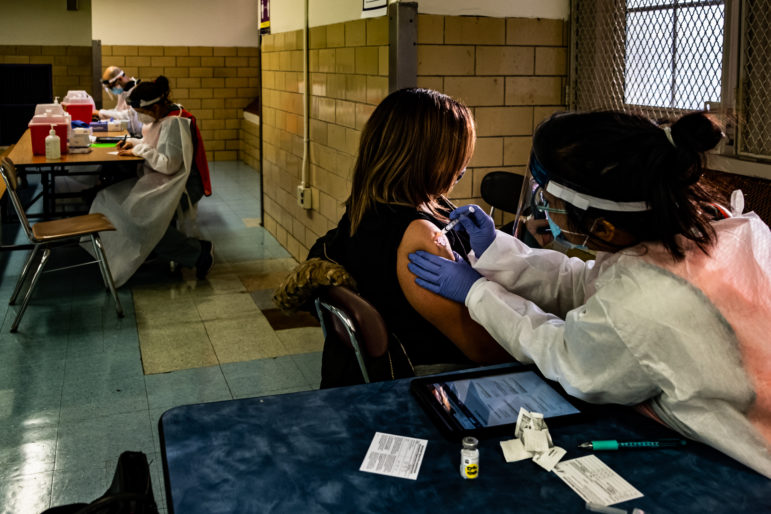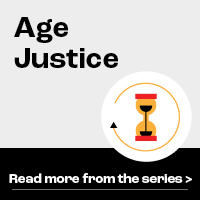On average, only 66 percent of nursing home staff across the city have been vaccinated. Brooklyn nursing homes are faring the worst with these efforts—only 57 percent of Kings County staff are fully vaccinated so far, the data show.

Adi Talwar
A person getting vaccinated at the South Bronx Educational Campus Vaccine Hubs located on St Ann’s Avenue.As the Delta variant of the COVID-19 virus leads to an uptick in positive cases, New York City nursing homes are struggling to vaccinate their staff.
As of Monday, almost 82 percent of residents in the more than 160 nursing homes in the five boroughs had received the COVID-19 vaccine, according to data from the state’s Department of Health. But on average, only 66 percent of staff had been vaccinated. Brooklyn nursing homes are faring the worst with these efforts—only 57 percent of Kings County staff have been fully vaccinated, the data show.
These numbers are falling short of vaccination goals set by multiple trade organizations. The American Health Care Association and LeadingAge, which both represent assisted living and long-term care facilities around the country, called for 75 percent of staff to be vaccinated by June 30. Fewer than 40 facilities in the city have achieved that goal.
New York nursing homes were hit especially hard by COVID-19, and have been a controversial focal point throughout the crisis: Gov. Andrew Cuomo has come under fire for initially allowing COVID-positive patients to return to nursing homes for care. In January, the state’s Attorney General accused his office of undercounting nursing home deaths by as much as 50 percent, leading some legislators to call for Cuomo’s resignation and federal authorities to launch an investigation. Data pulled from the Health Department counts more than 15,000 COVID-19 deaths at nursing homes and other assisted living facilities across the state since the pandemic began.
Some of the city’s nursing homes with low vaccine rates are also those that saw high numbers of fatalities. Of facilities that reported more than 50 COVID deaths, only six had vaccinated at least 75 percent of their staff.
The low vaccination rates are being echoed nationwide: Only one in five nursing homes across the country met the 75 percent threshold by the June 30 deadline, according to AARP (formerly American Association of Retired Persons).
New York’s staff vaccination rates are the second lowest of the nine Northeast states, falling ahead of only Pennsylvania, according to the most recent national data from the Centers for Medicare and Medicaid.
Meanwhile, the state reported 636 positive cases of COVID-19 among nursing home staff and 410 resident cases for the week ending July 4.
The highly transmissible Delta variant of the virus was responsible for 83 percent of all new cases nationally, according to Dr. Rochelle Walensky, director of the Centers for Disease Control and Prevention, who announced the data at a Senate hearing on Tuesday.
Still an individual choice
The slow movement on increasing vaccination among staff has led to talks of mandating vaccines for healthcare personnel—to mixed reactions around the country. On Wednesday, Mayor Bill de Blasio announced that the city will require employees of the public Health + Hospitals system, as well as city Health Department workers, to present proof of vaccination in order to work, or they’ll have to take weekly COVID tests. The new rule will go into effect in August, the mayor said.
Last week, a coalition of healthcare organizations across the country published a statement calling for a nationwide mandate for healthcare workers to get vaccinated against the virus.
“By requiring vaccination as a condition of employment we raise levels of vaccination for healthcare personnel, improve protection of our patients, and aid in reaching community protection,” they wrote. “As healthcare personnel, we’re committed to these goals.”
The statement, published by Cambridge University Press, also noted that mandating the flu shot for health workers led to vaccination rates of 94.4 percent—a 25 percent jump in compliance from before it was required.
Such a mandate is already being implemented in Europe. Earlier this month, France and Greece announced that all healthcare workers—including those who work with the elderly—are required to be vaccinated or they will not be allowed to work or receive pay. Italy issued the same mandate in April.
But such measures have not been easily accepted by healthcare staff in the United States. Some workers in other states subjected to COVID-19 vaccine requirements by their employers have participated in protests and taken legal action. On June 12, a judge in the Southern District of Texas rejected a lawsuit brought by over a 100 workers at a Houston hospital claiming that mandating a vaccine and firing workers based on their refusal would be unlawful termination.
Engaging the workforce
Some experts say that a mandate fails to recognize the core reasons staff members are still refusing vaccinations.
Jasmine Travers and her colleagues at NYU’s Hartford Institute for Geriatric Nursing published an editorial in the journal JADMA last month calling for health officials to collaborate with community members, unions and other vaccinated staff in the efforts to educate concerned workers.
“[Certified nursing assistants (CNAs)] also need to be engaged in dialogue with organizational leadership that is rooted in clear, consistent, comprehensive, and constant bidirectional communication,” they wrote. “This means providing CNAs forums to ask questions and voice concerns without facing reprisal.”
She cited a need to understand the reasons behind vaccine hesitancy, which can include factors as varied as cultural and language barriers, concern over missed wages due to lack of paid-time off and fear of leaving already overworked colleagues short-staffed.
Nursing home assistants, a workforce that is more than one-third women of color, receive consistently low pay and poor benefits, according to PHI, a nonprofit organization that monitors the sector. Nationally, certified nursing assistants make an average of $13.38 while working in an industry fraught with understaffing and high turnover.
“In an effort to better care for older adults in those settings, we need to take care of those who care for our loved ones,” Travers told City Limits.
For the time being, government officials and trade organizations are focusing on education about vaccine safety and efficacy.
Allan Campos, director of nursing for the Bedford Center for Nursing and Rehabilitation in Brooklyn, said that representatives from the state’s Department of Health came into the facility last week to encourage staff who weren’t yet vaccinated to get the shot.
That facility reported that only 41.5 percent of staff had been vaccinated as of Monday.
“Most people answer that they’re waiting,” Campos said, “A lot of them are scared because it’s a new thing.”
The union that represents nursing home staffers, 1199SEIU United Healthcare Workers East, has also made efforts to educate healthcare staff through meetings, mailings and social media. It seemed to be effective: A February survey of nearly 3,000 of its members in the region that includes New York City found that one-fourth of nursing home workers didn’t plan to get the vaccine—down from more than half of members in that workforce who said the same just two months prior.
On July 12, AARP wrote a letter of recommendations to Chiquita Brooks-LaSure, administrator of the Centers for Medicare & Medicaid Services, asking for additional testing at nursing homes and more transparency with data collection. It also urged CMS to consider vaccine outreach measures aimed at new staff members—due to high turnover rates in the industry—and the more than 50 percent of employees who work at more than one facility.
“The more we educate people about the vaccine, and the more we educate people who come into contact with the frailest people in our society, the better off we’ll all be for it,” said Bill Ferris, a NY state legislative representative with AARP.
“There was a tremendous amount of fatalities all across the country, including New York, including New York City, that had residents die from COVID,” noted Ferris. “That can never happen again.”
Liz Donovan is a Report for America corps member.










One thought on “New York Nursing Homes, Once COVID-19 Hot Spots, Now Struggle to Vaccinate Staff”
This is insane. MANDATE THE vaccine. How dare a segment of truly ignorant people put their arrogant opinions ahead of public safety? Especially ANYBODY who works with the public and ESPECIALLY the sick and elderly.